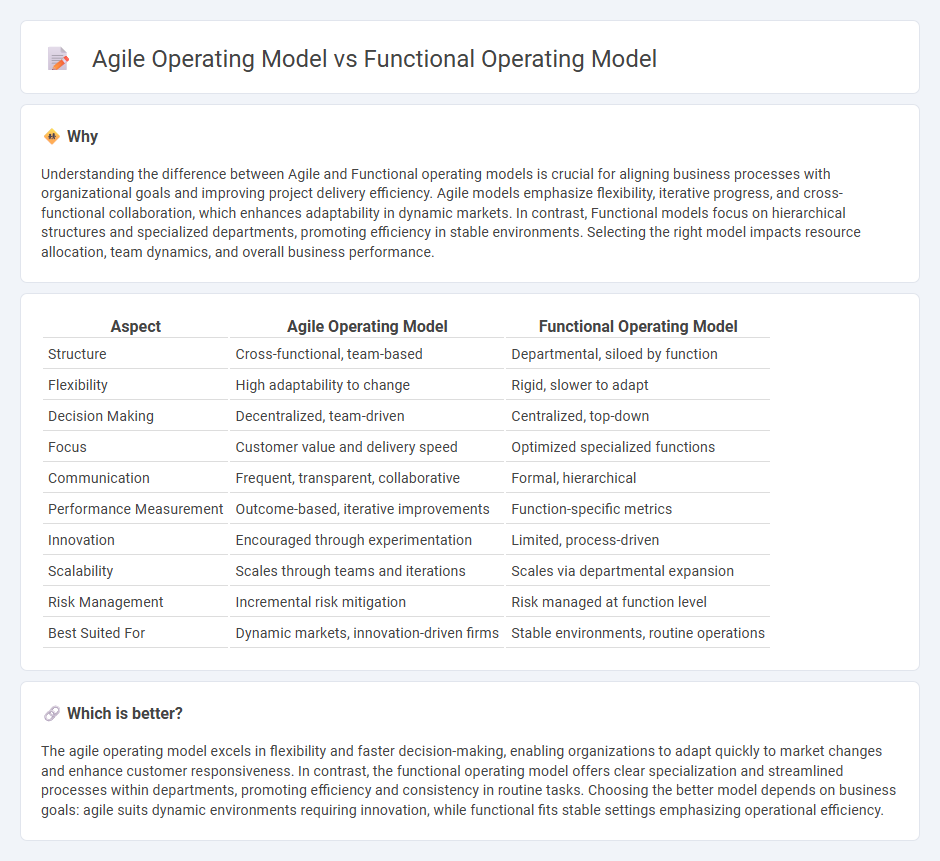
An agile operating model emphasizes flexibility, iterative progress, and cross-functional collaboration to respond swiftly to market changes, whereas the functional operating model relies on specialized departments with clear hierarchies and standardized processes to enhance efficiency. Organizations adopting agile models experience increased innovation and faster decision-making, while functional models excel in stability and operational discipline. Explore how each model impacts organizational performance and strategic goals to determine the best fit for your business.
Why it is important
Understanding the difference between Agile and Functional operating models is crucial for aligning business processes with organizational goals and improving project delivery efficiency. Agile models emphasize flexibility, iterative progress, and cross-functional collaboration, which enhances adaptability in dynamic markets. In contrast, Functional models focus on hierarchical structures and specialized departments, promoting efficiency in stable environments. Selecting the right model impacts resource allocation, team dynamics, and overall business performance.
Comparison Table
| Aspect | Agile Operating Model | Functional Operating Model |
|---|---|---|
| Structure | Cross-functional, team-based | Departmental, siloed by function |
| Flexibility | High adaptability to change | Rigid, slower to adapt |
| Decision Making | Decentralized, team-driven | Centralized, top-down |
| Focus | Customer value and delivery speed | Optimized specialized functions |
| Communication | Frequent, transparent, collaborative | Formal, hierarchical |
| Performance Measurement | Outcome-based, iterative improvements | Function-specific metrics |
| Innovation | Encouraged through experimentation | Limited, process-driven |
| Scalability | Scales through teams and iterations | Scales via departmental expansion |
| Risk Management | Incremental risk mitigation | Risk managed at function level |
| Best Suited For | Dynamic markets, innovation-driven firms | Stable environments, routine operations |
Which is better?
The agile operating model excels in flexibility and faster decision-making, enabling organizations to adapt quickly to market changes and enhance customer responsiveness. In contrast, the functional operating model offers clear specialization and streamlined processes within departments, promoting efficiency and consistency in routine tasks. Choosing the better model depends on business goals: agile suits dynamic environments requiring innovation, while functional fits stable settings emphasizing operational efficiency.
Connection
The agile operating model and functional operating model are connected through their complementary roles in optimizing organizational performance. While the functional operating model focuses on defining specific roles, responsibilities, and workflows within departments, the agile operating model introduces flexibility, cross-functional collaboration, and iterative processes to enhance responsiveness. Integrating agile principles into a functional operating model accelerates decision-making, improves adaptability, and drives continuous improvement across teams.
Key Terms
Structure
A functional operating model organizes teams based on specialized roles and departments, emphasizing clear hierarchies and standardized processes to ensure efficiency in routine tasks. An agile operating model structures teams cross-functionally, promoting collaboration, flexibility, and iterative development to quickly respond to changing market demands. Explore the key differences in organizational design to optimize your company's operational effectiveness.
Governance
A functional operating model emphasizes hierarchical governance with clear roles, centralized decision-making, and standardized processes ensuring consistency and control across departments. An agile operating model prioritizes decentralized governance, promoting cross-functional team autonomy, rapid decision cycles, and adaptive practices to enhance responsiveness and innovation. Explore more on how these governance structures impact organizational efficiency and adaptability.
Flexibility
A functional operating model organizes workflows by specialized departments, prioritizing efficiency but often limiting flexibility in quickly adapting to change. An agile operating model emphasizes cross-functional teams and iterative processes, enabling rapid response to shifting market demands and fostering continuous improvement. Explore how integrating agility into your operating model can boost adaptability and drive business growth.
Source and External Links
A Complete Guide to Operating Models: Strategies & Real ... - A functional operating model provides a blueprint detailing how an organization's structure, processes, technology, and people collaborate to deliver value aligned with strategy, covering roles and department hierarchies within the company's operational framework.
How to Design an Operating Model - Designing a functional operating model requires alignment with business strategy, focus on efficiency, customer-centricity, and collaboration, emphasizing streamlined processes and adaptable organizational structures.
Target Operating Model: The Ultimate Guide - A functional operating model outlines how processes, technology, governance, people, and organizational structure interconnect to efficiently achieve strategic goals and deliver value to stakeholders.
 dowidth.com
dowidth.com